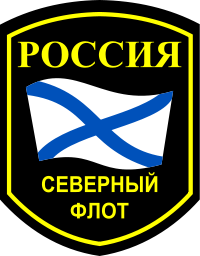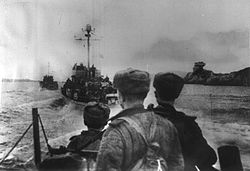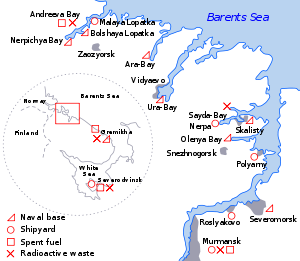- Northern Fleet
-
The Red Banner Northern Fleet (Russian: Северный флот, Severnyy Flot) is a unit of the Russian Navy that has access to the Barents and Norwegian Seas, the Arctic and Atlantic Oceans, and is responsible for the defense of northwestern Russia.[1] It was established in 1937 as part of the Soviet Navy. The fleet's headquarters, including its main base and administrative centre, is in Severomorsk; secondary bases are located throughout the Kola Gulf. During the Soviet Era it operated more than 200 submarines ranging from diesel-electric attack (SS) to nuclear-powered ballistic missile (SSBN) classes.
Contents
History
Navies of Russia Navy (1696–1917)
Soviet Navy (1917–1991)
Russian Navy (1991–Present[update])
The Arctic Sea and White Sea Flotillas
On June 19, 1916, the Russian Empire formed the Arctic Sea Flotilla (Флотилия Северного Ледовитого океана, or Flotiliya Severnogo Ledovitogo okeana) to safeguard Allied transportation routes through the Barents Sea from German naval forces. After the October Revolution, the Soviet Navy formed the White Sea Flotilla (Беломорская флотилия, or Belomorskaya flotiliya) in March 1920, based in Arkhangelsk. The White Sea Flotilla was renamed as the Naval Forces of the North Sea and disbanded in January 1923.
The Northern Flotilla
In the early 1933, the Northern Flotilla was formed by transferring ships from the Baltic Fleet. Two destroyers, two patrol boats (Smerch and Uragan), and two D-class submarines (Dekabrist (D-1) and Narodovolyets (D-2))[2] departed from Kronstadt on May 18, 1933 and arrived at Murmansk on August 5. Zakhar Zakupnev was the flotilla's first commander, and was succeeded by Konstantin Dushenov in March 1935.
A second group of ships (1 destroyer, 1 patrol boat, 1 submarine, 2 minesweepers) joined the flotilla at Soroka in September 1933. In 1935, Polyarny became the flotilla's main base. A flight of MBR-2 flying boats joined the unit at Murmansk in September 1935.[2]
The Northern Fleet
The Northern Fleet was created on May 11, 1937 by renaming the Northern Flotilla. Prior to this, the flotilla had coastal and air defense artillery, airfields, and new ships.
During the Winter War (1939–1940), the fleet blocked the Finnish military base in Petsamo. By June 1941, it included 8 destroyers, 15 submarines, 2 torpedo boats, 7 patrol boats, 2 minesweepers and 116 airplanes. In August 1940, the Soviets created the White Sea Military Base to defend the coastline, bases, ports and other installations; in 1941, it was renamed as the White Sea Flotilla. The flotilla's commanders were Rear-Admiral M.Dolinin (since August 1941), Vice Admiral G.Stepanov (since October), and subsequently Rear-Admiral Stepan Kucherov and Vice-Admiral Yuri Panteleyev.
World War II
During the Great Patriotic War of 1941-1945, the Northern Fleet defended the coastlines of the Rybachiy and Sredniy peninsulas, secured internal and external transportation routes, provided support to the maritime flank of the 14th Army, deployed marines, participated in the Petsamo-Kirkenes Operation in 1944; part of the Northern Fleet’s personnel (up to 10,000 men) took part in land warfare, as well. Among the air units of the Northern Fleet was the 121st Fighter Aviation Regiment. The Soviet submarine K-21 under the command of a Captain Nikolai Lunin attacked the German battleship Tirpitz at 71° 22' 2"N, 24° 34' 3"E. [1] The result of that attack is disputed, as no German sources confirm damage to the Tirpitz or to any other ship, but in the К-21 logbook two torpedo-burst were mentioned.
During the war, the Northern Fleet was reinforced with naval aircraft and ships from the Pacific Ocean and Caspian Sea. Also, Great Britain and the United States temporarily provided ships to the USSR in exchange for the Italian ships captured during the war and destined to be divided between the allies. At least two ships were involved: HMS Royal Sovereign and USS Milwaukee. During the war, the Northern Fleet secured safe passage for 1,463 ships in external convoys and 2568 ships in internal convoys. Its submarines, torpedo boats and aviation sank 192 transport ships and 70 military ships of the enemy. In addition, the Northern Fleet damaged 118 transport, military, and auxiliary ships.[3]
Awards
- Two airborne regiments, a squadron of submarine hunters, eight submarines, and the destroyer “Гремящий” (Gremyaschiy, or “rattler”) were promoted to the Soviet Guards' status for their skillful military operations.
- Many formations, units and ships were awarded with orders.
- Eighty-five sailors of the Northern Fleet received the title of the Hero of the Soviet Union (3 of them - twice).
- More than 48,000 men were awarded with orders and medals.
The Cold War
In the initial postwar period, the Northern Fleet were considered secondary to the Baltic and Black sea fleets. However, because of their more direct access to the open sea operational responsibility of the Atlantic Ocean were shifted to them in the 1950s.[2]
In September 1955, the Soviet navy was the first to launch a ballistic missile from a submarine. The first Soviet submarine “Б-67” (B-67) with ballistic missiles on board became a part of the Northern Fleet in June 1956. The submarine was a Zulu class submarine, NATO designation Zulu IV 1/2.
The 2nd Cruiser Division was formed on 31 May 1956 at Severomorsk, Murmansk Oblast. It's ships included the Sverdlov class cruisers (Project 68) Murmansk, Aleksandr Nevskiy, and Molotovsk, and the 121st Destroyer Brigade with 11 Gnevny class, Ognevoy class, and Skoryy class destroyers.[4] On 5 June 1969 the division was reorganised with the 170th Destroyer Brigade (8 Project 56 destroyers) and the 10th Anti-Submarine Warfare Brigade (10 Project 42 and 50 ASW vessels). On 1 April 1961 the division was renamed the 2nd Anti-Submarine Warfare Division.
On July 1, 1958, they raised the Soviet Navy pennant over the first Russian nuclear submarine K-3.
On July 17, 1962, after having traveled under the Arctic ice, the Soviet nuclear submarine Leninsky Komsomol (Vladimir Lenin’s Komsomol) surfaced in the North Pole region for the first time in the world and raised the Soviet flag and the Navy pennant (see USS Nautilus). Russian submarines have visited the North Pole region more than 300 times since then.
In September 1963, two nuclear submarines of the Northern Fleet made a journey under the Arctic ice cap and reached the Pacific Fleet for the first time in history. More than 25 Soviet submarines did the same in the following years.
On May 7, 1965 the Northern Fleet was awarded with the Order of the Red Banner.
In 1966, a submarine unit of the Northern Fleet made a group journey around the world, covering 25,000 nautical miles without surfacing.
By 1986, the Northern Fleet had almost 50% of the Soviet Navy's submarines.[2]
In the 1980s Soviet naval strategy shifted to an emphasis on bastion defense, fortifying the southern reaches of the Barents Sea for that purpose.
From 1968 to November 30, 2005, the 7th Operational Squadron (Russian: ru:7-я оперативная эскадра) was the main Atlantic operational force of the fleet.
The Museum of the Air Forces of the Northern Fleet opened on Aug. 20, 1976, in the closed settlement of Safonovo, Murmansk Oblast.
From the 1970s aircraft carriers began entering service with the Fleet. The nameship of the Kiev class of aircraft carriers (or 'heavy aircraft-carrying cruisers') Kiev, became operational in 1977, and Admiral Gorshkov was commissioned in 1987. Large nuclear powered missile-carrying cruisers, the Kirov-class Kirov and Kalinin also entered service from 1980. During the 1980s Soviet naval strategy shifted to an emphasis on bastion defense, fortifying the southern reaches of the Barents Sea for that purpose, and Russia has continued to employ that strategy.
After the Cold War
The 57th Mixed Ship Aviation Division transferred from the Baltic Fleet to the Northern Fleet in December 1991, having been previously the 57th Maritime Missile Aviation Division and supervising regiments of Tu-22s and electronic warfare Tu-16s from a headquarters at Bykhov, Mogilev Oblast, in the Belorussian SSR.[5] As the 57th Mixed Ship Aviation Division, the division commanded the 830th and 38th Shipborne Anti-Submarine Helicopter Regiments and the 279th Shipborne Fighter Aviation Regiment from Severomorsk-3 in Murmansk Oblast until 1 May 1998, when it was disbanded. The 5th Maritime Missile Aviation Division was also active within the Fleet for a long period, commanding the 524th and 574th Maritime Missile Aviation Regiments among other units. The 574th Regiment was based at Lakhta air base (Katunino) for a long period until disbanding in 2002.
The Oscar class submarine Kursk was destroyed in a torpedo accident during Fleet exercises in 2000. The submarine was previously based at Ara Bay. The Northern Fleet staged another series of major exercises in January 2004 involving thirteen ships and seven submarines in the Barents Sea. The involvement of Admiral Kuznetsov and Pyotr Velikiy was overshadowed however by two ballistic missile launch failures, made more embarrassing because President Vladimir Putin was afloat aboard the Typhoon class ballistic missile submarine Arkhangelsk to witness the tests. Neither Novomoskovsk nor Karelia were able to successfully launch what were apparently RSM-54 SLBMs.[6]
The flagship of the Northern Fleet, the heavy nuclear-powered guided missile cruiser Pyotr Velikiy, is named after Peter I of Russia (or Peter the Great). The Northern Fleet is perhaps best known for its many nuclear-powered vessels. In fact, about two thirds of all the Russian Navy's nuclear force is based there.
Sites
In addition to the main base at Severomorsk, the Northern Fleet has six more naval bases and several shipyards and spent fuel storage sites, according to the Bellona Foundation. Bases include Severomorsk, Polyarnyy, Olenya Bay, Gadzhiyevo (Yagelnaya/Sayda), Vidyayevo (Ura Bay and ARa Bay), Bolshaya Lopatka (Litsa Guba), and Gremikha - also a spent fuel storage site.
The spent fuel storage sites include Murmansk, which is also a shipyard and base for Arktika nuclear-powered icebreakers, Andreyeva Bay, and Severodvinsk, also a shipyard. Shipyards include Roslyakovo, Polyarnyy, Nerpa, and Malaya Lopatka.
Order of battle
This is a partial list of Northern Fleet submarines, ships, and air units currently in service. Among previous units was the 1st Submarine Flotilla, which among other units directed the 7th Submarine Division with nuclear attack submarines. 6th Submarine Division was disbanded in 1994, and 3rd Submarine Division in 1995.[7]
- 11th Task Force, Zaozersk
-
- TYPHOON-class SSBN Dmitriy Donskoy (ТК-208) (Nerpichya)
- Two other Typhoon class submarines are assigned to this squadron but are not active.
- 7th Task Group, Vidyaevo [8]
- Commmander
- RADM Aleksandr Ildashov
- SIERRA I-class SSN Kostroma
- SIERRA II-class SSN Nizhniy Novgorod[8]
- SIERRA II-class SSN Pskov (K-336)
- VICTOR-III-class SSN Daniil Moskovskiy (K-414)
- Commmander
- other submarines
-
- 12th Task Force, Gadzhiyevo
-
- Commander
- RADM Sergey Farkov [8]
- Commander
- 31st Submarine Task Group (Yagelnaya Bay, Sayda Inlet)
- Commander
- Captain 1st Rank Aleksandr Moiseyev [8]
- Delta IV-class SSBN Verkhoturye (K-51)
- Delta IV-class SSBN Ekaterinburg (K-84)
- Delta IV-class SSBN Tula (K-114)
- Delta IV-class SSBN Bryansk (K-117)
- Delta IV-class SSBN Kareliya (K-18)
- Delta IV-class SSBN Novomoskovsk (K-407)
- Commander
- 24th Submarine Task Group (Yagelnaya Bay, Sayda Inlet)
- Commanders
- Jul 1985-Oct 1987 VADM Vladimir Mikhaylovich Monastyrshin
- Oct 1987-Dec 1989 VADM Nikolay Ivanovich Mazin
- Dec 1989-Jun 1992 RADM Boris Sergeyevich Bogdanov
- Sep 1992-Jun 1996 RADM Sergey Anatolyevich Bliznyuk
- Jun 1996-Sep 1998 RADM Aleksandr Nikolayevich Bukin
- Sep 1998-Aug 2000 RADM Aleksey Vitalyevich Burilichev
- Aug 2000-xxx 200x RADM Vladimir Ivanovich Korolev
- xxx 200x-present RADM Anatoliy Minakov
- AKULA I-class SSN Pantera (K-317)
- AKULA I-class SSN Volk (K-461)
- AKULA I-class SSN Leopard (K-328)
- AKULA I-class SSN Tigr (K-154) [8]
- AKULA II-class SSN Vepr (K-157)
- AKULA II-class SSN Gepard (K-335)
- Commanders
-
- 43rd Missile Ship Task Group
-
- Commanders
- RADM Veregin
- RADM Avakyants
- RADM Kasatonov
- Present - RADM Aleksandr Turilin
- Commanders
- KUZNETSOV-class CV Admiral Flota Sovetskogo Soyuza Kuznetsov (063)
- KIROV-class CGN Pyotr Velikiy (099)
- SLAVA-class CG Marshal Ustinov (055)
- SOVREMENNYY-class DDG Gremyashchiy
- SOVREMENNYY-class DDG Admiral Ushakov
-
- 2nd Anti-Submarine Ship Task Group [8]
- UDALOY-I Class DD Vice Admiral Kulakov - post-overhaul trials
- UDALOY-I Class DD Severomorsk
- UDALOY-I Class DD Admiral Levchenko
- UDALOY-I Class DD Admiral Kharlamov
- UDALOY-II Class DD Admiral Chabanenko
-
- 4th Submarine Flotilla (Polyarnyy) [8]
- Commander
- Captain 1st Rank Aleksandr Gorbunov
- KILO-class SS Novosibirsk (B-401)
- KILO-class SS Vologda" (B-402)
- KILO-class SS Yaroslavl (B-808)
- KILO-class SS Kaluga (B-800)
- KILO-class SS Vladikavkaz (B-459)
- KILO-class SS Magnitogorsk (B-471)
- KILO-class SS Lipetsk (B-177)
- Commander
- 4th Submarine Flotilla (Polyarnyy) [8]
- Northern Fleet Aviation[9][10]
- 924th Independent Maritime Reconnaissance Aviation Regiment - HQ at Olenegorsk/Olenya - Tu-22M3;
- 279th Shipborne Fighter Aviation Regiment - HQ at Severomorsk-3 - Su-25UTG, Su-33;
- 73rd Independent Air Squadron - HQ at Kipelovo (Fedotovo) - Tu-142MK, Tu-142MR;
- 403rd Independent Mixed Aviation Regiment - HQ at Severomorsk-1 - An-12, An-26, Il-38, Tu-134;
- 830th Independent Shipborne Anti-Submarine Helicopter Regiment - HQ at Severomorsk-1 - Ka-27;
Commanders
Name Period of command Zakhar Aleksandrovich Zakupnev (Flag Officer First Rank) 29 May 1933-13 March 1935 Northern Flotilla
Konstantin Ivanovich Dushenov (Flag Officer First Rank) 13 March 1935-11 May 1937 Northern Fleet 11 May 1937-28 May 1938
Valentin Petrovich Drozd (Vice Admiral) 28 May 1938-26 July 1940 Arseniy Grigoryevich Golovko (Admiral) 26 July 1940-4 August 1946 Vasiliy Ivanovich Platonov (Admiral) 4 August 1946-23 April 1952 Andrey Trofimovich Chabanenko (Admiral) 23 April 1952-28 February 1962 Vladimir Afanasyevich Kasatonov (Admiral) 28 February 1962-2 June 1964 Semen Mikhaylovich Lobov (Fleet Admiral) 2 June 1964-3 May 1972 Georgiy Mikhaylovich Egorov (Fleet Admiral) 3 May 1972-1 July 1977 Vladimir Nikolayevich Chernavin (Fleet Admiral) 1 July 1977-16 December 1981 Arkadiy Petrovich Mikhaylovskiy (Admiral) 16 December 1981-25 February 1985 Ivan Matveyevich Kapitanets (Admiral) 25 February 1985-19 March 1988 Feliks Nikolayevich Gromov (Admiral) 19 March 1988-14 March 1992 Oleg Aleksandrovich Erofeyev (Admiral) 14 March 1992-29 January 1999 Vyacheslav Alekseyevich Popov (Admiral) 29 January 1999-15 December 2001 Gennady Aleksandrovich Suchkov (Admiral) 16 December 2001-29 May 2004 Mikhail Leopoldovich Abramov (Admiral) 29 May 2004-26 September 2005 Vladimir Sergeyevich Vysotsky (Admiral) 26 September 2005-11 September 2007 Nikolay Mikhaylovich Maksimov (Vice Admiral) 12 September 2007-30 March 2011 Andrey Olgertovich Volozhinskiy (Rear Admiral) - Acting 30 March 2011-24 June 2011 Vladimir Ivanovich Korolev (Vice Admiral) 24 June 2011- References
- ^ A civilian Northern Fleet also existed prior to the Second World War
- ^ a b c d Norman Polmar, Guide to the Soviet Navy, Fourth Edition (1986), United States Naval Institute, Annapolis Maryland, ISBN 0-87021-240-0
- ^ Great Soviet Encyclopedia/Большая Советская Энциклопедия; entry: Soviet Red Banner Northern Fleet.
- ^ Michael Holm, 2nd Anti-Submarine Warfare Division, accessed October 2011
- ^ Michael Holm, 57th Heavy Bomber Aviation Division, accessed October 2011
- ^ Jane's Fighting Ships, 2004-05, p.29
- ^ Michael Holm, 3rd Submarine Division, accessed October 2011
- ^ a b c d e f g Kommersant VLAST No.7(760), 25 Feb 2008
- ^ Ввс Вмф
- ^ Air Forces Monthly, August 2007 issue.
This article includes content derived from the Great Soviet Encyclopedia, 1969–1978.
Further reading
- Kristian Åtland, Russia's Armed Forces and the Arctic: All Quiet on the Northern Front?, Contemporary Security Policy, Vol. 32, Issue 2, 2011
External links
- (Russian) Official site at mil.ru
- (English) Bellona Foundation site about the Russian Northern Fleet
Pacific Fleet
Categories:- Military units and formations established in 1933
- Naval units and formations of the Soviet Union
- Military in the Arctic
- Russian Navy
- Barents Sea
- Russian fleets
Wikimedia Foundation. 2010.



